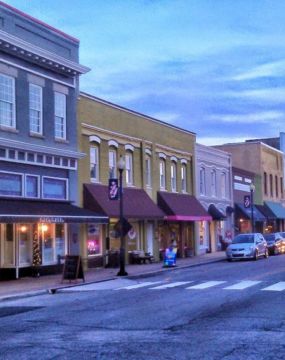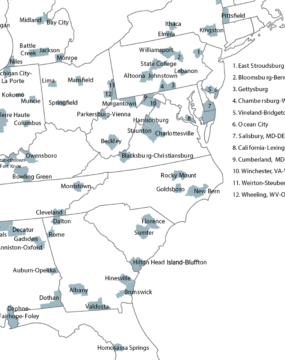Welcome to our blog
Keep up with our latest demographic insights

It has been a little over a year since the pandemic shut down workplaces and schools across North Carolina. In this post, we detail what Carolina Demography has learned about the pandemic’s effect on the educational system in NC. First, let’s start with a short timeline: On March 15, 2020, NC Governor Roy Cooper signed an executive order to close all K-12 public schools for a minimum of two weeks. During the next three weeks,…

The following post is an email message we received from Bob Coats, Governor's Census Liaison at the North Carolina Office of State Budget and Management, regarding the proposed changes to address how urban areas will be identified after the 2020 Census data are released and how metropolitan statistical areas will be defined. This email has been lightly edited and posted here with his approval. You can read what the recommendations are and how this will…

Two recently published Federal Register Notices address how urban areas will be identified after the 2020 Census data are released and how metropolitan areas will be defined. In this post, we detail what the recommendations are, and how that will impact communities in North Carolina. Changing metropolitan definition would impact 3 NC metros Federal Register notice: Recommendations from the Metropolitan and Micropolitan Statistical Area Standards Review Committee to the Office of Management and Budget Concerning…

Way back in 2019, which now seems like eons ago, I wrote a column for Vox about the importance of the upcoming 2020 Census. It started off like this: “For demographers like me, the census is kind of like our Super Bowl, if the Super Bowl only took place once a decade — and if the foundation of your representative democracy hinged on the winner of the game.” The 2020 Census kicked off its nationwide…

Across the country, fewer students are showing up in traditional public schools because of the ongoing COVID-19 pandemic. We have looked at attendance data from the North Carolina Department of Public Instruction to understand how declines in enrollment vary across the state and which grades are impacted. How much is school attendance down? Statewide, nearly 63,000 fewer students were attending public schools in Month 2 of 2020-21 compared to 2019-20, a loss of -4.4%. Public…

Residents and employees of nursing homes and similar long-term care facilities (LTCFs) are more vulnerable to COVID-19 related illness and death than the general population. In fact, nationally 38% of COVID-19 deaths have been associated with LTCFs. Because of this, the Centers for Disease Control recommended that individuals in LTCFs be prioritized in COVID-19 vaccination distribution plans. In North Carolina Governor Roy Cooper’s vaccination rollout plan, he included long-term care residents and staff along with…

It’s been nearly a year since our lives were first disrupted by the global COVID-19 pandemic. What do cumulative case counts, deaths, and vaccination levels look like in North Carolina? Here’s the latest data according to NC DHHS data accessed on 2/11/2021. I used the projected 2020 population from the state demographer to calculate levels per 10,000 residents. COVID-19 Cases There have been 805,889 cases recorded in North Carolina counties or 758 per 10,000 residents.…

North Carolina’s Hispanic population is now greater than one million people, with 1,026,000 residents in 2019. The state’s Hispanic/Latino population grew from just over 75,000 in 1990 to 800,000 in 2010. Between 2010 and 2019, the U.S. Census Bureau estimates that North Carolina’s Hispanic population grew by 226,000 new residents, an increase of 28.3%, faster than the growth of this population nationwide (19.6%). The Hispanic/Latinx communities in Mecklenburg County (153K) and Wake County (116K) comprise…

We recently worked with the Chamber for a Greater Chapel Hill-Carrboro, the governments of the Towns of Chapel Hill, Carrboro, and Hillsborough, and Orange County to streamline existing processes for acquiring, updating, and maintaining the data they use for their community reports and presentations. As part of that work, we've released a series of reports looking at demographic and economic trends in Orange County, NC. Here are some highlights from Carolina Demography's report on community…

We recently worked with the Chamber for a Greater Chapel Hill-Carrboro, the governments of the Towns of Chapel Hill, Carrboro, and Hillsborough, and Orange County to streamline existing processes for acquiring, updating, and maintaining the data they use for their community reports and presentations. As part of that work, we've released a series of reports looking at demographic and economic trends in Orange County, NC. Here are some highlights from Carolina Demography's report on community…
Your support is critical to our mission of measuring, understanding, and predicting population change and its impact. Donate to Carolina Demography today.